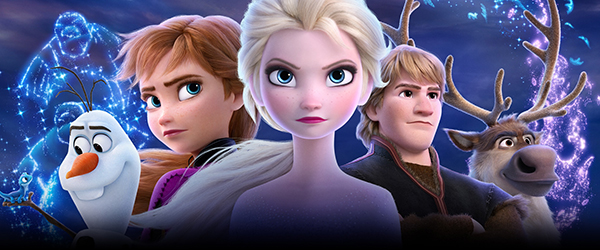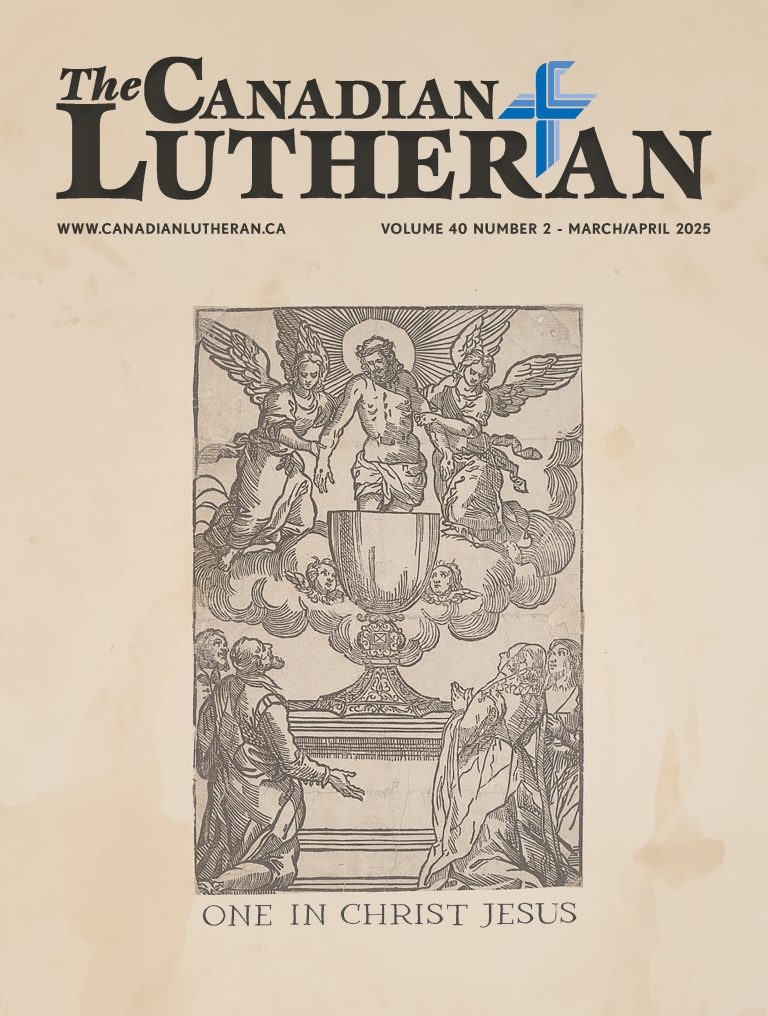Frozen II: Knee-Deep in a Religious Blizzard

by Ted Giese
Frozen II, the sequel to Disney’s massive 2013 hit Frozen, sees sisters Queen Elsa and Princess Anna continue to grapple with Elsa’s growing magical powers. Set in the fictional mid-19th century Norwegian kingdom of Arendelle, the animated film solves the mystery of the source of Elsa’s powers and uncovers other family secrets as the sisters, Kristoff, his reindeer Sven, and the magic snowman Olaf venture into the enchanted forest of Northuldra deep in the north.
Frozen had an obvious and rather conventional villain—the duplicitous Prince Hans—but Frozen II’s villain is only revealed in the film’s last third when the mystery of the curse enchanting the forest of Northuldra is revealed and broken by Elsa and Anna. As a result, the film is less about struggling against an antagonist and more about the transformation of its two main characters. Anna becomes an even more capable young woman eventually taking on the mantle of Queen in Arendelle, and Elsa’s transformation continues to follow the trajectory of her magical abilities.
A careful viewing of both films reveals another transformation.
In Frozen, a Lutheran bishop presided over Elsa’s coronation. But with the film’s focus on Elsa’s mysterious magical abilities, it quickly shifted away from Christian underpinnings to a more pagan-oriented worldview. Frozen II completes this transformation. Some fantasy film franchises—like those based on J.R.R. Tolkien’s Lord of the Rings and C.S. Lewis’ Chronicles of Narnia—retrain a great of Christian form and substance when translated to film.
This is not the case with Frozen, however, which is loosely based on Hans Christian Andersen’s Danish 1845 fairytale The Snow Queen. There writers/directors Chris Buck and Jennifer Lee excise the original Christian content. Now in Frozen II, they chart a new story mostly untethered from Andersen’s original source material, again choosing not to include any of Anderson’s Christian themes or concepts [the original Snow Queen, includes praying the Lord’s Prayer, for example, and concludes with a Bible verse: “Truly, I say to you, unless you turn and become like children, you will never enter the kingdom of heaven” (Matthew 18:3).].
The Faith of the Sámi People
After Frozen was released in 2013, Buck and Lee received criticism for not consulting the indigenous semi-nomadic reindeer-herding Sámi people who live in northern Scandinavia and parts of Russia. This time they consulted with Sámi elders in the making of Frozen II. Previously they borrowed from Sámi culture rather haphazardly, but with this film Buck and Lee endeavoured to show more respect to the customs, material culture, and pre-Christian religious heritage of the Sámi. (Some North Americans might better know the term “Laplanders,” which is analogous to calling an Inuit person an Eskimo).
Disney also sought consultation with Middle Eastern South Asians for their 2019 live-action remake of Aladdin. On the one hand it’s positive that Disney wants to avoid misrepresenting diverse communities in their films; on the other hand, viewers with a particular interest in this may want to ask if Disney is doing a good job accomplishing its goal.
While the Sámi religion includes a mixture of pagan elements like animism, shamanism, and polytheism, the fact that Disney has set Frozen and Frozen II in the mid-19th century needs to be explored. Historically, Roman Catholics first brought Christianity to the Sámi peoples in the 13th century. Following the Reformation, Lutherans continued bringing the Christian faith to the regions where the Sámi lived. This happened, as these things do, sometimes with genuine Christ-like gentleness and sometimes in heavy-handed unChristian ways. By the 17th century, the faith of the Sámi people was either Lutheran or Russian Orthodox; most pre-Christian religious ways were not commonly taught or practiced.
Why is this important? Frozen might just be a cartoon, but when Disney goes to great lengths to show sensitivity to the Sámi people, they might wish to also respect their unfolding history. Viewers will want to ask if this failure to portray history accurately portray is by ignorance or by design. By the time the fictional story of Frozen and Frozen II takes place, both the Sámi and Norwegian peoples shared a common Christian faith as Lutherans—a fact in no way acknowledged in the film.
By the time the fictional story of Frozen and Frozen II takes place, both the Sámi and Norwegian peoples shared a common Christian faith as Lutherans—a fact in no way acknowledged in the film.
How then do Buck and Lee incorporate their representation of pre-Christian Sámi religion into Frozen II? The film’s first song is “All Is Found,” an animistic lullaby sung in a flashback to the young Elsa and Anna by their mother Iduna. The song attributes human characteristics and behaviors to a river in which the river is describes as “mother” in its last verse, implying the river has a soul. Also the magic of the northern kingdom of Northuldra in Frozen II centres on the four elements of earth, water, air, and fire, with a mysterious fifth element at their centre.
Interested viewers will want to consider how many of these ideas re-emerged in Western European academia and popular culture during the 19th century neo-pagan revival movement. A movement not led by indigenous and aboriginal people but rather by Caucasian Europeans fuelled by romanticism and feelings of guilt over the history of colonialism. This amorphous movement continues, contributing to the formation of a wide range of neo-pagan belief systems ranging from modern Druids to Gerald-Massy-style Wicca and even groups as far flung and radical as the Vril Society of Nazi Germany. Gradually as common ideas associated with neo-pagan revivalism became entrenched in secularized universities, indigenous communities and peoples around the world received encouragement to reignite or, in some cases, conserve their historic beliefs and practices.
In the course of Frozen II Elsa hears the song of the mysterious fifth element calling to her from the north. Following the call, she goes through a kind of deification, apotheosis, so that by the end of the film she transforms into the fifth element becoming a demi-god with control over the magic of the four other elements. An example is how Elsa harnesses the magical power of the spirit of water in the form of a horse, riding it on the river, and when needed freezing it so she can ride the water horse on land. While there is death and rebirth elements to Elsa’s story, this is not a biblical allusion to the crucifixion, burial, and resurrection of Jesus in Christianity. Any attempt to shoehorn Christianity into the film will end up like a stepsister trying on Cinderella’s glass slipper.
As the film unfolds, the villain becomes clear. As told to the girls in a flashback by their father King Agnarr, a curse unexpectedly fell over the enchanted woods of Northuldra when the native peoples were visited by Elsa and Anna’s grandfather King Runeard. The final revelation that her grandfather built a river dam to control rather than help the people acts as the catalyst for Elsa’s apotheosis. This revelation reframes their grandfather as an evil colonialist and explains why the curse enveloped the enchanted forest. King Runeard’s murder of the Northuldra leader and his desire to dominate and control the northern people angered the magical four elements who enacted the curse.
Christian parents and grandparents might want to consider how a storyline like this can subtly imply that grandchildren should not trust the beliefs of their own grandparents, especially if they don’t match up with the film’s magic worldview. In the end Elsa and Anna become the bridge between the enchanted world of magic in Northuldra and the non-magical world of Arendelle, restoring a balance lost by the greed and prejudicial arrogance of King Runeard. It is also revealed that Iduna, the sister’s mother, is from Northuldra and it’s through her side of the family Elsa received her magical abilities.
A spoon full of sugar makes the medicine go down
The film is beautifully rendered and the computer animation is an improvement on the original; Olaf again plays the witty and charming fool; Kristoff finally proposes to Anna and she accepts his proposal; Anna becomes Queen; and Elsa appears happy and more confident in her new life. There is a resolution and happy ending for everyone. One lackluster part of the film is the music. While serviceable, it is not as great as the music from the original film and lacks an anthem comparable to “Let it Go.” Perhaps the best parts of Frozen II are when Elsa and Anna are together as sisters. Unfortunately, Buck and Lee split up these two characters for a large portion of the film. The sugar coating provided, while enjoyable, doesn’t hide Frozen II’s subtle and obvious taste of politics and paganism.
Considering the film concludes with a strong theme of “balance” between Elsa and Anna, and that Elsa’s transformation sees her shed nearly all of her previous Arendelle ways in favour of her new demi-god shamanist role amongst the people of Northuldra as protector of the enchanted forest, viewers might expect Anna to represent the Christian side of that balance. As mentioned before, in Frozen a Lutheran Bishop presided over Elsa’s coronation as Queen of Arendelle. It would then stand to reason that this would be the case for Anna’s coronation as Queen. While engaged to be married, Anna and Kristoff have no wedding ceremony which logically would likewise involve the character of the Lutheran Bishop. If these things did happen, they do so off-camera, a choice by Buck and Lee that undercuts their theme of balance.
The way this is all handled may be unsatisfying for some and there might be no good way to address this; the lopsided theme of balance while sounding nice on paper in its execution becomes simply an idealistic weakness or perhaps a hollow virtue-signaling gesture. Over the years Disney has come a long way from films like Pocahontas but clearly still has a long way to go when dealing with these ideas in their films.
While on the surface Frozen II appears to be a film for children, it’s good to remember it is still a film made by adults. As a result, there are parts that end up being a little too complicated for a young child. Some parents and grandparents will likely spend time answering questions. To be fair, there are adults who love these Disney films as much as children. Perhaps the balance Buck and Lee fail to accomplish isn’t just the balance between Arendelle and Northuldra but rather the balance between telling a story for adults and for children.
This the leads to a final thought: some of the questions asked by children will likely tread into spiritual concerns. This is where recognizing that the film contains an abundance of non-Christian ideas will help families. Christian families who don’t have a consistent pattern of regular church attendance and don’t include Sunday school and religious homeschooling for their kids during the week will likely be tempted to brush off these questions when asked because they will either seem unimportant or too challenging. Because a film like Frozen II is a global release, families from non-Christian religious traditions around the world will likewise need to be able to talk about their beliefs in relationship to what the film presents. A film like Frozen II can certainly act as an encouragement for families to step up the religious instruction of their kids. If a family doesn’t teach its children what to believe, films like Frozen II will be happy teach their kids for them.
———————
Rev. Ted Giese is lead pastor of Mount Olive Lutheran Church, Regina, Saskatchewan, Canada; a contributor to The Canadian Lutheran, Reporter; and movie reviewer for the “Issues, Etc.” radio program. Follow Pastor Giese on Twitter @RevTedGiese.




